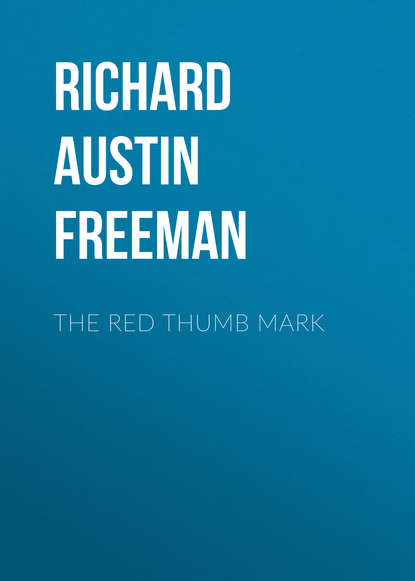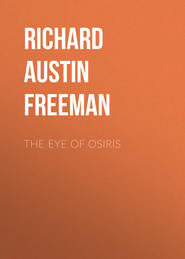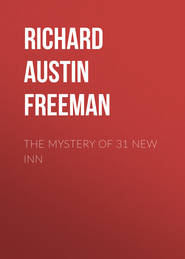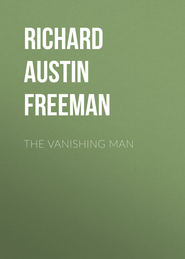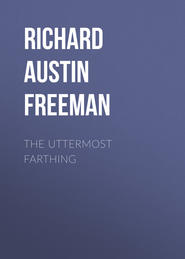По всем вопросам обращайтесь на: info@litportal.ru
(©) 2003-2024.
✖
The Red Thumb Mark
Настройки чтения
Размер шрифта
Высота строк
Поля
"Ah!" said the judge; and his face relaxed into a dry smile, while the jury broke out into unconcealed grins.
"It was evident to me," continued Thorndyke, "that the experts would be unable to distinguish the real from the forged thumb-prints, and, that being so, that they would look for some collateral evidence to guide them. I, therefore, supplied that collateral evidence. Now, if ten prints are taken, without special precautions, from a single finger, it will probably happen that no two of them are exactly alike; for the finger being a rounded object of which only a small part touches the paper, the impressions produced will show little variations according to the part of the finger by which the print is made. But a stamp such as I have used has a flat surface like that of a printer's type, and, like a type, it always prints the same impression. It does not reproduce the finger-tip, but a particular print of the finger, and so, if ten prints are made with a single stamp, each print will be a mechanical repetition of the other nine. Thus, on a sheet bearing twenty finger-prints, of which ten were forgeries made with a single stamp, it would be easy to pick out the ten forged prints by the fact that they would all be mechanical repetitions of one another; while the genuine prints could be distinguished by the fact of their presenting trifling variations in the position of the finger.
"Anticipating this line of reasoning, I was careful to make each print with a different stamp and each stamp was made from a different thumb-print, and I further selected thumb-prints which varied as widely as possible when I made the stamps. Moreover, when I made the real thumb-prints, I was careful to put the thumb down in the same position each time as far as I was able; and so it happened that, on the sheet submitted to the experts, the real thumb-prints were nearly all alike, while the forgeries presented considerable variations. The instances in which the witnesses were quite certain were those in which I succeeded in making the genuine prints repeat one another, and the doubtful cases were those in which I partially failed."
"Thank you, that is quite clear," said the judge, with a smile of deep content, such as is apt to appear on the judicial countenance when an expert witness is knocked off his pedestal. "We may now proceed, Mr. Anstey."
"You have told us," resumed Anstey, "and have submitted proofs, that it is possible to forge a thumb-print so that detection is impossible. You have also stated that the thumb-print on the paper found in Mr. Hornby's safe is a forgery. Do you mean that it may be a forgery, or that it actually is one?"
"I mean that it actually is a forgery."
"When did you first come to the conclusion that it was a forgery?"
"When I saw it at Scotland Yard. There are three facts which suggested this conclusion. In the first place the print was obviously produced with liquid blood, and yet it was a beautifully clear and distinct impression. But such an impression could not be produced with liquid blood without the use of a slab and roller, even if great care were used, and still less could it have been produced by an accidental smear.
"In the second place, on measuring the print with a micrometer, I found that it did not agree in dimensions with a genuine thumb-print of Reuben Hornby. It was appreciably larger. I photographed the print with the micrometer in contact and on comparing this with a genuine thumb-print, also photographed with the same micrometer in contact, I found that the suspected print was larger by the fortieth of an inch, from one given point on the ridge-pattern to another given point. I have here enlargements of the two photographs in which the disagreement in size is clearly shown by the lines of the micrometer. I have also the micrometer itself and a portable microscope, if the Court wishes to verify the photographs."
"Thank you," said the judge, with a bland smile; "we will accept your sworn testimony unless the learned counsel for the prosecution demands verification."
He received the photographs which Thorndyke handed up and, having examined them with close attention, passed them on to the jury.
"The third fact," resumed Thorndyke, "is of much more importance, since it not only proves the print to be a forgery, but also furnishes a very distinct clue to the origin of the forgery, and so to the identity of the forger." (Here the court became hushed until the silence was so profound that the ticking of the clock seemed a sensible interruption. I glanced at Walter, who sat motionless and rigid at the end of the bench, and perceived that a horrible pallor had spread over his face, while his forehead was covered with beads of perspiration.) "On looking at the print closely, I noticed at one part a minute white mark or space. It was of the shape of a capital S and had evidently been produced by a defect in the paper—a loose fibre which had stuck to the thumb and been detached by it from the paper, leaving a blank space where it had been. But, on examining the paper under a low power of the microscope, I found the surface to be perfect and intact. No loose fibre had been detached from it, for if it had, the broken end or, at least, the groove in which it had lain, would have been visible. The inference seemed to be that the loose fibre had existed, not in the paper which was found in the safe, but in the paper on which the original thumb-mark had been made. Now, as far as I knew, there was only one undoubted thumb-print of Reuben Hornby's in existence—the one in the 'Thumbograph.' At my request, the 'Thumbograph' was brought to my chambers by Mrs. Hornby, and, on examining the print of Reuben Hornby's left thumb, I perceived on it a minute, S-shaped white space occupying a similar position to that in the red thumb-mark; and when I looked at it through a powerful lens, I could clearly see the little groove in the paper in which the fibre had lain and from which it had been lifted by the inked thumb. I subsequently made a systematic comparison of the marks in the two thumb-prints; I found that the dimensions of the mark were proportionally the same in each—that is to say, the mark in the 'Thumbograph' print had an extreme length of 26/1000 of an inch and an extreme breadth of 14.5/1000 of an inch, while that in the red thumb-mark was one-fortieth larger in each dimension, having an extreme length of 26.65/1000 of an inch and an extreme breadth of 14.86/1000 of an inch; that the shape was identical, as was shown by superimposing tracings of greatly enlarged photographs of each mark on similar enlargements of the other; and that the mark intersected the ridges of the thumb-print in the same manner and at exactly the same parts in the two prints."
"Do you say that—having regard to the facts which you have stated—it is certain that the red thumb-mark is a forgery?"
"I do; and I also say that it is certain that the forgery was executed by means of the 'Thumbograph.'"
"Might not the resemblances be merely a coincidence?"
"No. By the law of probabilities which Mr. Singleton explained so clearly in his evidence, the adverse chances would run into untold millions. Here are two thumb-prints made in different places and at different times—an interval of many weeks intervening. Each of them bears an accidental mark which is due not to any peculiarity of the thumb, but to a peculiarity of the paper. On the theory of coincidences it is necessary to suppose that each piece of paper had a loose fibre of exactly identical shape and size and that this fibre came, by accident, in contact with the thumb at exactly the same spot. But such a supposition would be more opposed to probabilities even than the supposition that two exactly similar thumb-prints should have been made by different persons. And then there is the further fact that the paper found in the safe had no loose fibre to account for the mark."
"What is your explanation of the presence of defibrinated blood in the safe?"
"It was probably used by the forger in making the thumb-print, for which purpose fresh blood would be less suitable by reason of its clotting. He would probably have carried a small quantity in a bottle, together with the pocket slab and roller invented by Mr. Galton. It would thus be possible for him to put a drop on the slab, roll it out into a thin film and take a clean impression with his stamp. It must be remembered that these precautions were quite necessary, since he had to make a recognisable print at the first attempt. A failure and a second trial would have destroyed the accidental appearance, and might have aroused suspicion."
"You have made some enlarged photographs of the thumb-prints, have you not?"
"Yes. I have here two enlarged photographs, one of the 'Thumbograph' print and one of the red thumb-print. They both show the white mark very clearly and will assist comparison of the originals, in which the mark is plainly visible through a lens."
He handed the two photographs up to the judge, together with the 'Thumbograph,' the memorandum slip, and a powerful doublet lens with which to examine them.
The judge inspected the two original documents with the aid of the lens and compared them with the photographs, nodding approvingly as he made out the points of agreement. Then he passed them on to the jury and made an entry in his notes.
While this was going on my attention was attracted by Walter Hornby. An expression of terror and wild despair had settled on his face, which was ghastly in its pallor and bedewed with sweat. He looked furtively at Thorndyke and, as I noted the murderous hate in his eyes, I recalled our midnight adventure in John Street and the mysterious cigar.
Suddenly he rose to his feet, wiping his brow and steadying himself against the bench with a shaking hand; then he walked quietly to the door and went out. Apparently, I was not the only onlooker who had been interested in his doings, for, as the door swung to after him, Superintendent Miller rose from his seat and went out by the other door.
"Are you cross-examining this witness?" the judge inquired, glancing at Sir Hector Trumpler.
"No, my lord," was the reply.
"Are you calling any more witnesses, Mr. Anstey?"
"Only one, my lord," replied Anstey—"the prisoner, whom I shall put in the witness-box, as a matter of form, in order that he may make a statement on oath."
Reuben was accordingly conducted from the dock to the witness-box, and, having been sworn, made a solemn declaration of his innocence. A brief cross-examination followed, in which nothing was elicited, but that Reuben had spent the evening at his club and gone home to his rooms about half-past eleven and had let himself in with his latchkey. Sir Hector at length sat down; the prisoner was led back to the dock, and the Court settled itself to listen to the speeches of the counsel.
"My lord and gentlemen of the jury," Anstey commenced in his clear, mellow tones, "I do not propose to occupy your time with a long speech. The evidence that has been laid before you is at once so intelligible, so lucid, and so conclusive, that you will, no doubt, arrive at your verdict uninfluenced by any display of rhetoric either on my part or on the part of the learned counsel for the prosecution.
"Nevertheless, it is desirable to disentangle from the mass of evidence those facts which are really vital and crucial.
"Now the one fact which stands out and dominates the whole case is this: The prisoner's connection with this case rests solely upon the police theory of the infallibility of finger-prints. Apart from the evidence of the thumb-print there is not, and there never was, the faintest breath of suspicion against him. You have heard him described as a man of unsullied honour, as a man whose character is above reproach; a man who is trusted implicitly by those who have had dealings with him. And this character was not given by a casual stranger, but by one who has known him from childhood. His record is an unbroken record of honourable conduct; his life has been that of a clean-living, straightforward gentleman. And now he stands before you charged with a miserable, paltry theft; charged with having robbed that generous friend, the brother of his own father, the guardian of his childhood and the benefactor who has planned and striven for his well-being; charged, in short, gentlemen, with a crime which every circumstance connected with him and every trait of his known character renders utterly inconceivable. Now upon what grounds has this gentleman of irreproachable character been charged with this mean and sordid crime? Baldly stated, the grounds of the accusation are these: A certain learned and eminent man of science has made a statement, which the police have not merely accepted but have, in practice, extended beyond its original meaning. That statement is as follows: 'A complete, or nearly complete, accordance between two prints of a single finger … affords evidence requiring no corroboration, that the persons from whom they were made are the same.'
"That statement, gentlemen, is in the highest degree misleading, and ought not to have been made without due warning and qualification. So far is it from being true, in practice, that its exact contrary is the fact; the evidence of a finger-print, in the absence of corroboration, is absolutely worthless. Of all forms of forgery, the forgery of a finger-print is the easiest and most secure, as you have seen in this court to-day. Consider the character of the high-class forger—his skill, his ingenuity, his resource. Think of the forged banknotes, of which not only the engraving, the design and the signature, but even the very paper with its private watermarks, is imitated with a perfection that is at once the admiration and the despair of those who have to distinguish the true from the false; think of the forged cheque, in which actual perforations are filled up, of which portions are cut out bodily and replaced by indistinguishable patches; think of these, and then of a finger-print, of which any photo-engraver's apprentice can make you a forgery that the greatest experts cannot distinguish from the original, which any capable amateur can imitate beyond detection after a month's practice; and then ask yourselves if this is the kind of evidence on which, without any support or corroboration, a gentleman of honour and position should be dragged before a criminal court and charged with having committed a crime of the basest and most sordid type.
"But I must not detain you with unnecessary appeals. I will remind you briefly of the salient facts. The case for the prosecution rests upon the assertion that the thumb-print found in the safe was made by the thumb of the prisoner. If that thumb-print was not made by the prisoner, there is not only no case against him but no suspicion of any kind.
"Now, was that thumb-print made by the prisoner's thumb? You have had conclusive evidence that it was not. That thumb-print differed in the size, or scale, of the pattern from a genuine thumb-print of the prisoner's. The difference was small, but it was fatal to the police theory; the two prints were not identical.
"But, if not the prisoner's thumb-print, what was it? The resemblance of the pattern was too exact for it to be the thumb-print of another person, for it reproduced not only the pattern of the ridges on the prisoner's thumb, but also the scar of an old wound. The answer that I propose to this question is, that it was an intentional imitation of the prisoner's thumb-print, made with the purpose of fixing suspicion on the prisoner, and so ensuring the safety of the actual criminal. Are there any facts which support this theory? Yes, there are several facts which support it very strongly.
"First, there are the facts that I have just mentioned. The red thumb-print disagreed with the genuine print in its scale or dimensions. It was not the prisoner's thumb-print; but neither was it that of any other person. The only alternative is that it was a forgery.
"In the second place, that print was evidently made with the aid of certain appliances and materials, and one of those materials, namely defibrinated blood, was found in the safe.
"In the third place, there is the coincidence that the print was one which it was possible to forge. The prisoner has ten digits—eight fingers and two thumbs. But there were in existence actual prints of the two thumbs, whereas no prints of the fingers were in existence; hence it would have been impossible to forge a print of any of the fingers. So it happens that the red thumb-print resembled one of the two prints of which forgery was possible.
"In the fourth place, the red thumb-print reproduces an accidental peculiarity of the 'Thumbograph' print. Now, if the red thumb-print is a forgery, it must have been made from the 'Thumbograph' print, since there exists no other print from which it could have been made. Hence we have the striking fact that the red thumb-print is an exact replica—including accidental peculiarities—of the only print from which a forgery could have been made. The accidental S-shaped mark in the 'Thumbograph' print is accounted for by the condition of the paper; the occurrence of this mark in the red thumb-print is not accounted for by any peculiarity of the paper, and can be accounted for in no way, excepting by assuming the one to be a copy of the other. The conclusion is thus inevitable that the red thumb-print is a photo-mechanical reproduction of the 'Thumbograph' print.
"But there is yet another point. If the red thumb-print is a forgery reproduced from the 'Thumbograph' print, the forger must at some time have had access to the 'Thumbograph.' Now, you have heard Mrs. Hornby's remarkable story of the mysterious disappearance of the 'Thumbograph' and its still more mysterious reappearance. That story can have left no doubt in your minds that some person had surreptitiously removed the 'Thumbograph' and, after an unknown interval, secretly replaced it. Thus the theory of forgery receives confirmation at every point, and is in agreement with every known fact; whereas the theory that the red thumb-print was a genuine thumb-print, is based upon a gratuitous assumption, and has not had a single fact advanced in its support.
"Accordingly, gentlemen, I assert that the prisoner's innocence has been proved in the most complete and convincing manner, and I ask you for a verdict in accordance with that proof."
As Anstey resumed his seat, a low rumble of applause was heard from the gallery. It subsided instantly on a gesture of disapproval from the judge, and a silence fell upon the court, in which the clock, with cynical indifference, continued to record in its brusque monotone the passage of the fleeting seconds.
"He is saved, Dr. Jervis! Oh! surely he is saved!" Juliet exclaimed in an agitated whisper. "They must see that he is innocent now."
"Have patience a little longer," I answered. "It will soon be over now."
Sir Hector Trumpler was already on his feet and, after bestowing on the jury a stern hypnotic stare, he plunged into his reply with a really admirable air of conviction and sincerity.
"My lord and gentlemen of the jury: The case which is now before this Court is one, as I have already remarked, in which human nature is presented in a highly unfavourable light. But I need not insist upon this aspect of the case, which will already, no doubt, have impressed you sufficiently. It is necessary merely for me, as my learned friend has aptly expressed it, to disentangle the actual facts of the case from the web of casuistry that has been woven around them.
"Those facts are of extreme simplicity. A safe has been opened and property of great value abstracted from it. It has been opened by means of false keys. Now there are two men who have, from time to time, had possession of the true keys, and thus had the opportunity of making copies of them. When the safe is opened by its rightful owner, the property is gone, and there is found the print of the thumb of one of these two men. That thumb-print was not there when the safe was closed. The man whose thumb-print is found is a left-handed man; the print is the print of a left thumb. It would seem, gentlemen, as if the conclusion were so obvious that no sane person could be found to contest it; and I submit that the conclusion which any sane person would arrive at—the only possible conclusion—is, that the person whose thumb-print was found in the safe is the person who stole the property from the safe. But the thumb-print was, admittedly, that of the prisoner at the bar, and therefore the prisoner at the bar is the person who stole the diamonds from the safe.
"It is true that certain fantastic attempts have been made to explain away these obvious facts. Certain far-fetched scientific theories have been propounded and an exhibition of legerdemain has taken place which, I venture to think, would have been more appropriate to some place of public entertainment than to a court of justice. That exhibition has, no doubt, afforded you considerable amusement. It has furnished a pleasing relaxation from the serious business of the court. It has even been instructive, as showing to what extent it is possible for plain facts to be perverted by misdirected ingenuity. But unless you are prepared to consider this crime as an elaborate hoax—as a practical joke carried out by a facetious criminal of extraordinary knowledge, skill and general attainments—you must, after all, come to the only conclusion that the facts justify: that the safe was opened and the property abstracted by the prisoner. Accordingly, gentlemen, I ask you, having regard to your important position as the guardians of the well-being and security of your fellow-citizens, to give your verdict in accordance with the evidence, as you have solemnly sworn to do; which verdict, I submit, can be no other than that the prisoner is guilty of the crime with which he is charged."
Sir Hector sat down, and the jury, who had listened to his speech with solid attention, gazed expectantly at the judge, as though they should say: "Now, which of these two are we to believe?"





